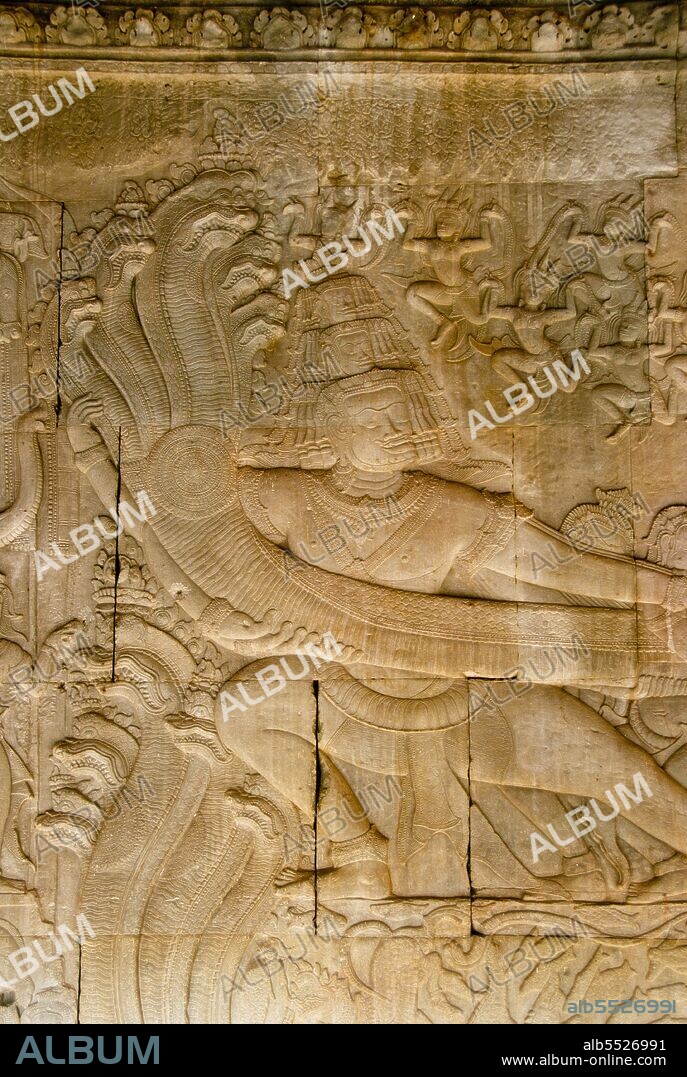alb5526991
Cambodia: The demon king Ravana holding the head of the five-headed naga (mythical snake) known as Vasuki, Churning of the Ocean of Milk (Sea of Milk), South Wing, East Gallery, Angkor Wat.

|
Add to another lightbox |
|
Add to another lightbox |



Title:
Cambodia: The demon king Ravana holding the head of the five-headed naga (mythical snake) known as Vasuki, Churning of the Ocean of Milk (Sea of Milk), South Wing, East Gallery, Angkor Wat.
Caption:
Angkor Wat was built for King Suryavarman II (ruled 1113-50) in the early 12th century as his state temple and capital city. As the best-preserved temple at the Angkor site, it is the only one to have remained a significant religious centre since its foundation – first Hindu, dedicated to the god Vishnu, then Buddhist. It is the world's largest religious building. The temple is at the top of the high classical style of Khmer architecture. It has become a symbol of Cambodia, appearing on its national flag, and it is the country's prime attraction for visitors. Angkor Wat combines two basic plans of Khmer temple architecture: the temple mountain and the later galleried temple, based on early South Indian Hindu architecture. It is designed to represent Mount Meru, home of the devas in Hindu mythology: within a moat and an outer wall 3.6 kilometres (2.2 mi) long are three rectangular galleries, each raised above the next. At the centre of the temple stands a quincunx of towers.
Credit:
Album / David Henley/Pictures from History/Universal Images Group
Releases:
Model: No - Property: No
Rights questions?
Rights questions?
Image size:
3292 x 4904 px | 46.2 MB
Print size:
27.9 x 41.5 cm | 11.0 x 16.3 in (300 dpi)
Keywords:
ANCIENT ANGKOR • ANCIENT CITY • ANGKOR VAT • ANGKOR WAT • ARCHITECTURE • ART • ARTS • ASIA IMAGES • ASIA PICTURES • ASIA • ASIAN IMAGES • ASIAN PICTURES • ASIAN • ASURA • BAS RELIEF • BAS-RELIEF • BUDDHISM • BUDDHISM, BHUTANESE • BUDDHIST • CAMBODIA • CAMBODIAN • CULT, BUDDHIST • CULT, HINDUISM • CULTURE • DAEMON • DAVID HENLEY • DEMON • DEVA • DEVIL • HINDUISM • HISTORIA UNIVERSAL • HISTORICAL IMAGES • HISTORICAL PICTURES • HISTORICAL • HISTORY IMAGES • HISTORY PICTURES • HISTORY • KAMPUCHEA • KAMPUCHEAN • KING • LEGEND • MONUMENT • NAGA • PREAH PISNULOK • RAVANA • RELIEF • RELIGION • SATAN • SCULPTED • SCULPTURE • SIEM REAP • SOUTHEAST ASIA • SURYAVARMAN II • SURYAVARMAN • TEMPERA • TEMPLE • TEMPLES • UNESCO WORLD HERITAGE SITE • VASUKI • VISHNU
 Pinterest
Pinterest Twitter
Twitter Facebook
Facebook Copy link
Copy link Email
Email
